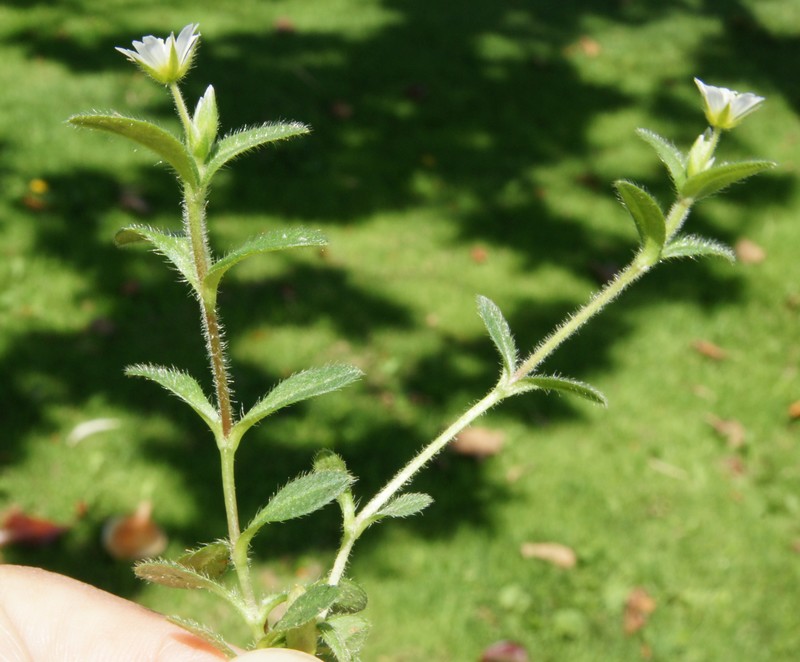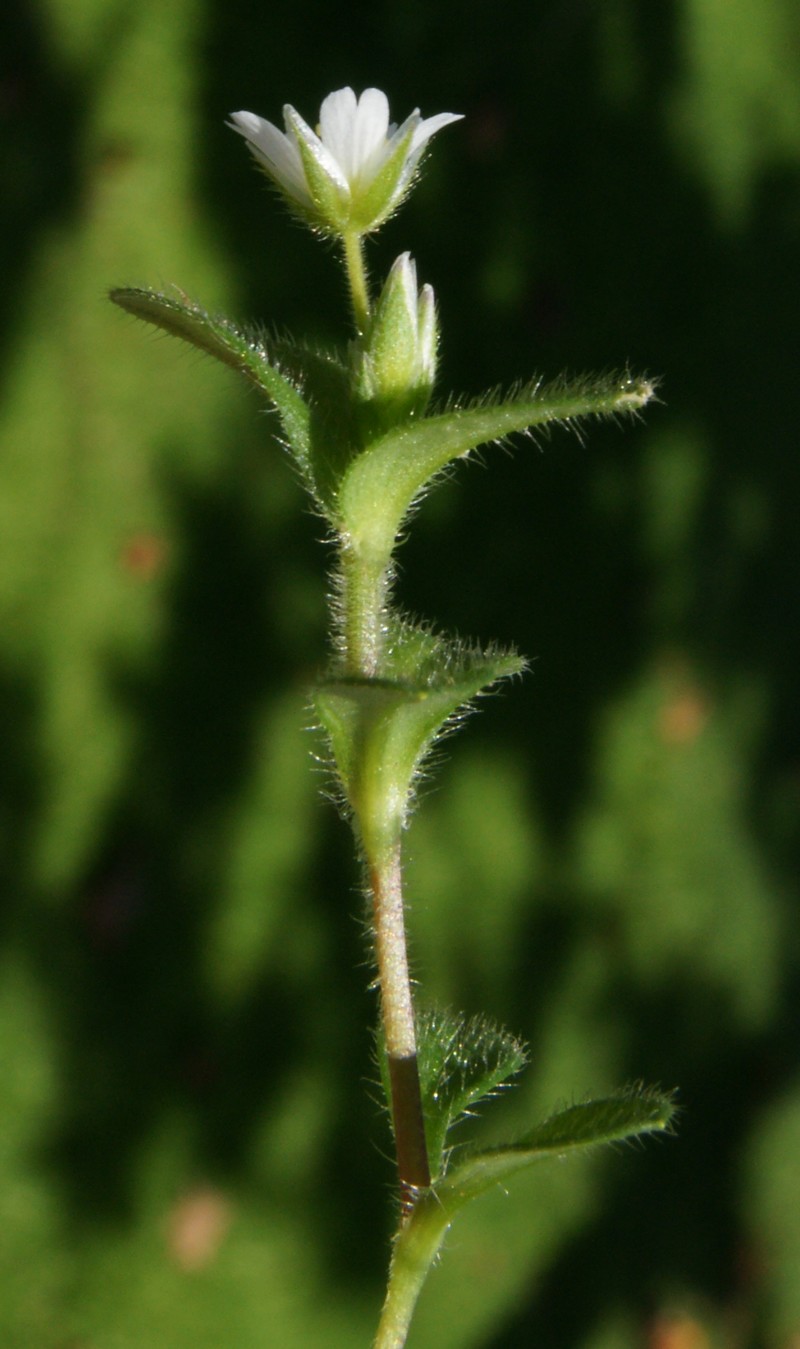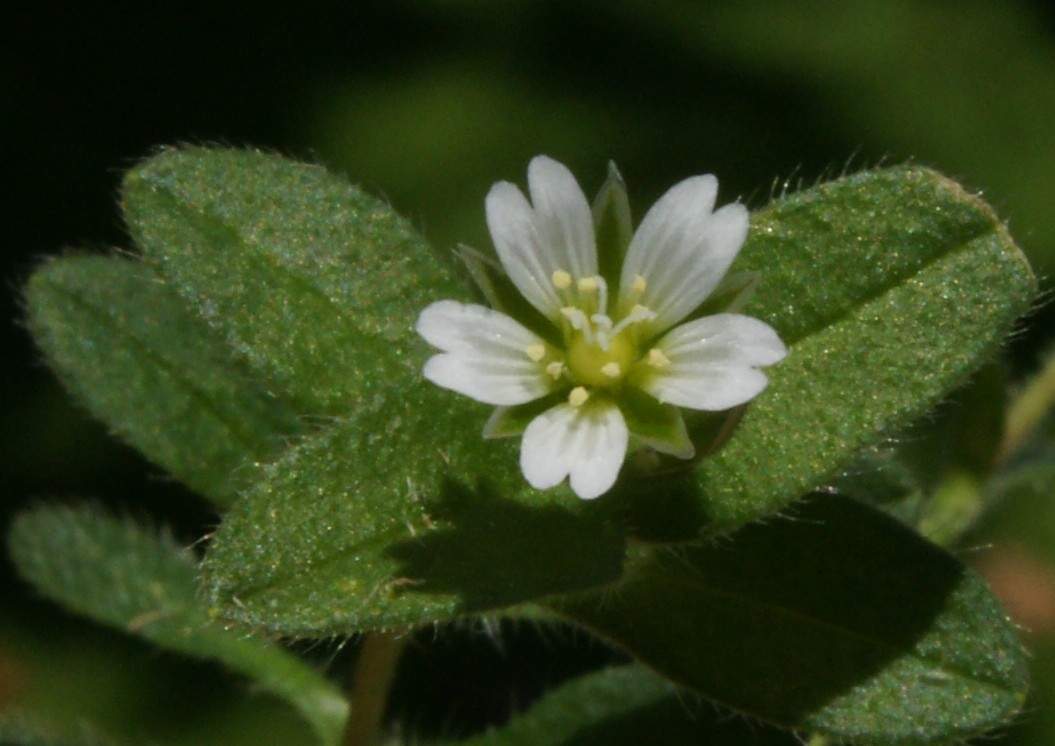|
Cerastium holosteoides Fr., Novit. Fl. Suec. Alt. 126 1828. (syn Cerastium alpestre Schur; Cerastium alpigenum Schur; Cerastium andinum Phil.; Cerastium caespitosum var. montevidense (Rohrb.) Malme; Cerastium caespitosum var. pseudoalpestre Bech.; Cerastium connatum L.C.Beck; Cerastium fontanum var. eglandulosum Gartner; Cerastium fontanum var. glandulosum Gartner; Cerastium fontanum var. glandulosum (Boenn.) P.D.Sell; Cerastium fontanum f. glutinosum (Möschl) M.B.Wyse Jacks.; Cerastium fontanum f. gracile (Hayek) M.B.Wyse Jacks.; Cerastium fontanum f. holosteoides (Fr.) M.B.Wyse Jacks.; Cerastium fontanum subsp. holosteoides (Fr.) Salman, Ommering & de Voo; Cerastium fontanum var. lucens (Druce) P.D.Sell; Cerastium fontanum subsp. scandicum Gartner; Cerastium fontanum var. tibeticum (Edgew. & Hook.f.) C.Y.Wu & L.H.Zhou; Cerastium fontanum var. vulgare (Hartm.) M.B.Wyse Jacks.; Cerastium fontanum subsp. vulgare (Hartm.) Greuter & Burdet; Cerastium glandulosum (Boenn.) Schur; Cerastium holosteoides var. glabrescens (G.Mey.) Hyl.; Cerastium holosteoides subsp. glandulosum (Boenn.) I.V.Sokolova; Cerastium holosteoides subsp. serpentini (Novák) Dostál; Cerastium holosteoides var. vulgare (Hartm.) Hyl.; Cerastium holosteoides subsp. vulgare (Hartm.) Buttler; Cerastium macrocarpum Steven ex Ledeb.; Cerastium malachiforme Schur; Cerastium minus Schur; Cerastium pseudosylvaticum Schur; Cerastium scandicum (Gartner) Kuzen.; Cerastium sylvaticum Opiz; Cerastium uliginosum Hegetschw.; Cerastium viscidum Christm.; Cerastium viscosum L.; Cerastium viscosum var. elongatum Hook.; Cerastium viscosum var. glabrescens G.Mey.; Cerastium viscosum var. glandulosum Boenn.; Cerastium vulgare Hartm.; Cerastium vulgare var. holosteoides (Fr.) Fr.; Cerastium vulgatum var. americanum Ser.; Cerastium vulgatum var. andinum A.Gray; Cerastium vulgatum f. lucens Druce; Cerastium vulgatum var. montevidense Rohrb.; Cerastium vulgatum var. peruvianum A.Gray; Stellaria viscosa Link);
. Temp. & Subarctic Eurasia to New Guinea (Mt. Kaindi): Afghanistan, Albania, Altay, Amur, Austria, Azores, Baleares, Baltic States, Belarus, Belgium, Bulgaria, Buryatiya, Canary Is., Central European Rus, China North-Central, China South-Central, China Southeast, Chita, Corse, Czechoslovakia, Denmark, East European Russia, Finland, France, Føroyar, Germany, Great Britain, Greece, Hungary, Iceland, Inner Mongolia, Iran, Iraq, Ireland, Irkutsk, Italy, Japan, Jawa, Kamchatka, Kazakhstan, Khabarovsk, Kirgizstan, Korea, Krasnoyarsk, Krym, Kuril Is., Madeira, Magadan, Manchuria, Mongolia, Morocco, Netherlands, New Guinea, North Caucasus, North European Russi, Northwest European R, Norway, Pakistan, Philippines, Poland, Portugal, Primorye, Qinghai, Romania, Sakhalin, Sardegna, Sicilia, South European Russi, Spain, Sri Lanka, Sudan, Sweden, Switzerland, Taiwan, Tibet, Transcaucasus, Tunisia, Turkey, Turkey-in-Europe, Tuva, West Himalaya, West Siberia, Xinjiang, Yakutskiya, Yugoslavia; Introduced into: Alabama, Alaska, Alberta, Aleutian Is., Amsterdam-St.Paul Is, Antipodean Is., Argentina South, Arizona, Arkansas, Ascension, Bermuda, Bolivia, British Columbia, California, Chatham Is., Chile Central, Chile North, Chile South, Colombia, Colorado, Connecticut, Crozet Is., Delaware, District of Columbia, Florida, Free State, Georgia, Greenland, Guatemala, Haiti, Idaho, Illinois, Indiana, Iowa, Juan Fernández Is., Kansas, Kentucky, Kerguelen, Kermadec Is., KwaZulu-Natal, Labrador, Lesotho, Louisiana, Macquarie Is., Maine, Manitoba, Marion-Prince Edward, Maryland, Massachusetts, Mexico Northeast, Michigan, Minnesota, Mississippi, Missouri, Montana, Nebraska, Nevada, New Brunswick, New Hampshire, New Jersey, New Mexico, New York, New Zealand North, New Zealand South, Newfoundland, Norfolk Is., North Carolina, North Dakota, Northwest Territorie, Nova Scotia, Ogasawara-shoto, Ohio, Oklahoma, Ontario, Pennsylvania, Peru, Pitcairn Is., Prince Edward I., Québec, Rhode I., Saskatchewan, South Carolina, South Dakota, South Georgia, St.Helena, Tennessee, Texas, Tristan da Cunha, Tubuai Is., Utah, Venezuela, Vermont, Virginia, Washington, West Virginia, Wisconsin, Wyoming, Yukon as per POWO; . SK1826 02 April 2019 : 3 posts by 2 authors. Attachments (8) – around 750 kb each.
Location: Ghandruki, Kaski Dt. Which Stellaria ..??
Appears to be Cerastium fontanum Baumg.
Pl. check. I think it will be Cerastium holosteoides as per POWO (syn: Cerastium fontanum subsp. vulgare ( . 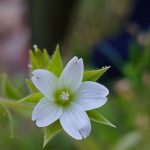 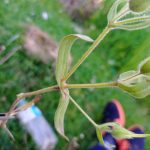  Id request for this species of Arenaria .: 3 images. Please have look on these small incision on petals. Location pampore jammu and kashmir
It is better to post habit pictures, foliage etc. for proper ID. such cropped images may some times mislead the identification process.
Pl. post a habit image.
To me styles appear to be 5.
It is not Arenaria, as it has 3 styles.
To me it appears to be Cerastium, which has 3 or 5 styles.
I checked in comparative images at Cerastium and species listed in Flora of Pakistan with keys and Checklist of Nepal, but could not find a match.
What are the species listed in your area?
Habit. Thanks. I need list of species reported in your area or in J and K.
We have areneria serpylifolia and A.kashmirica
No, It is not Arenaria.
I am asking about Cerastium. We have 3 sp. Of Cerastium here.
C.davuricum.
C.cerastoides.
C.fontanum.
Does not match with either of the three as per comparative images at Cerastium
Also could not find a match with any species as per Flora of Pakistan.
Surely Cerastium, bifid petals and 5 styles, more pictures would help but lax flowers and petals shorter than sepals suggest C. fontanum
Yes it resembles with C. fontanum…
Taxonomy of Cerastium fontanum looks quite complex.
Also no habit and lower portion image, makes the task further difficult.
Cerastium fontanum does not have distribution in our area as per POWO and CoL and also looks different as per GBIF specimens.
Cerastium fontanum subsp. triviale (Link) Jalas (syn. of Cerastium glomeratum as per POWO) looks different as per GBIF specimens.
Cerastium fontanum subsp. grandiflorum H. Hara appears somewhat close as per POWO, GBIF specimens- one, two, three, but has only distribution in Nepal as per CoN and POWO and CoL. But it appears close to your area as per distribution in POWO.
But I am still not sure. On further consideration, it appears close to Cerastium holosteoides as per POWO (syn: Cerastium fontanum subsp. vulgare (Hartman) Greuter & Burdet of Flora of China)
Let me confirm it sir
Yes it is what we have been treating as C. fontanum (var. triviale), it is our choice whether we want to follow POWO and call it C. glomeratum or follow WFO and call it Cerastium fontanum subsp. vulgare.
It is high time we decide and put boldly on our website which Database we are following. We can’t tell the World that we are following different databases for different plants, which one for this particular taxon?
Cerastium fontanum Baum. subsp. vulgare (Hartman) Greuter & Burdet, Willdenowia. 12: 37. 1982.
Differing from subsp. fontanum in viscid hairs on inflorescence, petals almost as long as sepals shorter, 9-13 mm long capsules and smaller seeds.
Photographed from Sunnyvale California. . Confusion between Cerastium fontanum subsp. vulgare and Cerastium glomeratum:
Both these species appear quite confusing as per details at POWO: Cerastium fontanum subsp. vulgare (syn. of Cerastium holostedides) and Cerastium glomeratum. To get the clear idea let us see the descriptions from Flora of China. 1. Cerastium fontanum subsp. vulgare (syn. of Cerastium holostedides)
Herbs short-lived perennial or annual, 15–40 cm tall. Stems caespitose or simple, suberect; sterile stems decumbent; flowering stems pilose and/or glandular pubescent all round. Basal leaves ovate, obovate-lanceolate, ovate-spatulate, or spatulate, 5–13 × 3–10 mm, both surfaces pilose, base attenuate into a petiole; cauline leaves subsessile, ovate, oblong, or narrowly ovate-oblong, 1–3(–4) × 0.3–1(–1.2) cm, both surfaces pilose or pubescent, margin densely ciliate, apex acute. Cyme terminal, spreading, lax, up to 40-flowered; bracts leaflike, ovate, 3–5 mm, both surfaces glandular pubescent. Pedicel slender, 0.5–2.5 cm, densely glandular pubescent, recurved after anthesis. Sepals oblong- or ovate-lanceolate, 5–6 mm, abaxially densely glandular pubescent, margin membranous or narrowly so. Petals shorter than or equaling sepals. Petals obovate or obovate-oblong, shorter than to 2 × as long as sepals, apex 2-lobed. Stamens shorter than petals. Ovary ovoid, ca. 2 mm. Styles 5, linear, slightly longer than ovary. Capsule cylindric, 8–10 mm, ca. 2 × as long as calyx, 10-toothed, teeth usually recurved. Seeds brown, usually 0.4–0.8 mm in diam., tuberculate. Fl. Apr–Jun, fr. May–Jul.Forests, forest margins, mountain slopes, hilltop grasslands, fields, sandy soils, rock crevices, roadsides; 100–4300 m. 2. Cerastium glomeratum Thuillier Herbs annual, 10–20 cm tall. (Annual herb with straggling, ascending stems up to 45 cm as per POWO) Stems simple or caespitose, densely villous, distally glandular pubescent. Proximal leaves spatulate; distal leaves obovate-elliptic, 1.5–2.5 × 0.5–1 cm, base attenuate into a short petiole, both surfaces villous, midvein prominent, margin ciliate. Inflorescence of compact, cymose clusters (glomerules); rachis densely glandular pubescent; bracts leaflike, ovate-elliptic, densely pubescent. Pedicel 1–3 mm, densely pubescent. Sepals 5, lanceolate, ca. 4 mm, abaxially densely long glandular pubescent, margin narrowly membranous, apex acute. Petals 5, white, oblong, subequaling or slightly longer than sepals, base pilose, apex 2-lobed. Stamens shorter than sepals. Styles 5. Capsule cylindric, 1.5–2 × as long as calyx, 10-toothed. Seeds brown, compressed triangular, tuberculate. Fl. Mar–Apr, fr. May–Jun. Forest margins, mountain slope grasslands, sandy riversides; 100–3700 m. So the main difference appears to be in cyme terminal, spreading, lax, up to 40-flowered, Sepals oblong- or ovate-lanceolate and Petals shorter than or equaling sepals. Petals obovate or obovate-oblong in Cerastium fontanum subsp. vulgare (syn. of Cerastium holostedides) compared to inflorescence of compact, cymose clusters (glomerules), Sepals 5, lanceolate and Petals 5, white, oblong, subequaling or slightly longer than sepals in Cerastium glomeratum Thuillier. Let us compare Indian taxa, best to start with FBI, which recognises
1. var. glomerata, now recognised as C. glomeratum, rightly so in Flora of India
2. var. trivialis which was recognised as C. fontanum subsp. triviale in Flora of India
3. var. grandiflora, now considered synonym of C. fontanum subsp. grandiflorum (Edgew.) H.Hara Found in Tibet and Nepal
Other two varieties were doubtful. Flora of India rightly recognised two taxa C. glomeratum and C. fontanum subsp. triviale. If we follow POWO, there is no confusion as latter is relegated to synonymy of former.
However, if we follow World Flora online (and Flora of China) we have to look for all these differences. / References:
POWO Catalogue of Life The Plant List Ver.1.1 GBIF (High resolution specimens) Flora of China India Biodiversity Portal |
Disclaimer
1. For any mistake in identification or for becoming efloraofindia e-group member (for contributing towards building of efloraofindia or otherwise), pl. mail to indiantreepix@googlegroups.com or itpmods@googlegroups.com
2. For better viewing of species’ pages, colour scheme & formatting is being followed as: Description of the species, Details of other flora species on the same page, Uses/ harms, Distribution, Abundance/ Location/ Flowering time & date, Habit & habitat, Etymology & pronunciation, Other interesting information, stories etc., Others, Botanical names, Common names, Main point of discussion below, Discussion about Botanical names.
Navigation
- Award for eFloraofIndia
- Colour scheme & formatting
- Copyrights, Permissions, Citations
- eFloraofIndia appreciated
- Names of Plants in India site
- Flowersofindia site
- Posting Guidelines
- For members’ information
- Logo, Tagline, Acronym
- Volunteers required
- ‘Pitamah’ of eFloraofIndia
- ‘अजेय’ ‘Ajey’ of eFloraofIndia
- ‘Saarthi’ ‘सारथि’ of eFloraofIndia
- ‘Jewel’ of eFloraofIndia
- ‘Grassman’ of eFloraofIndia

